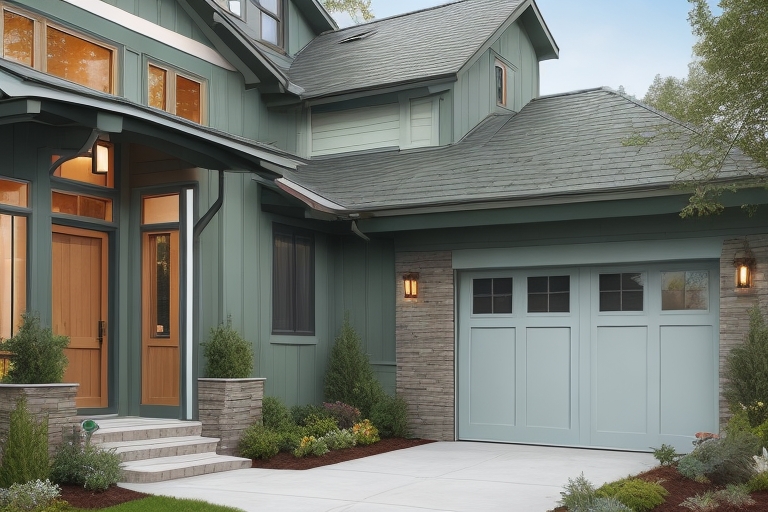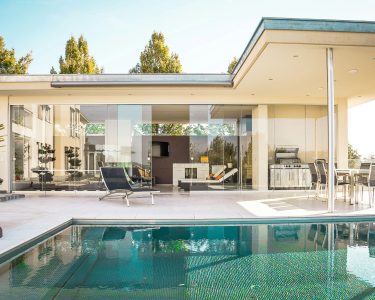The concept of ‘home’ has always been a cornerstone of human civilization. It’s where we find solace, create memories, and build futures. As global awareness about environmental sustainability grows, the way we perceive and construct our homes is undergoing a transformative shift. No longer are homes just about aesthetic appeal and comfort; they are now also about responsibility, conservation, and forward-thinking.
In the past, homes were built with a primary focus on immediate needs and aesthetic preferences. Brick by brick, plank by plank, homes rose as symbols of security and prosperity. However, as the years rolled by, the consequences of such construction methods began to surface. The energy inefficiency of older homes, combined with the use of non-sustainable materials, started taking a toll on both the environment and homeowners’ wallets.
Today, the narrative is changing. Home renovation is no longer just about updating a space or increasing its aesthetic appeal. It’s about retrofitting homes to be more energy-efficient, reducing their carbon footprint, and ensuring they are in harmony with their surroundings. This shift is not just driven by a sense of responsibility but also by practical benefits. Sustainable homes often translate to reduced utility bills, healthier living environments, and increased property values.
Moreover, the definition of sustainability in home renovation has expanded. It’s not just about installing solar panels or rainwater harvesting systems; it’s about holistic sustainability. This includes using eco-friendly materials in construction, optimizing natural light, ensuring proper insulation, and even choosing sustainable decor. Every nail, every paint stroke, and every brick plays a part in this green narrative.
The rise of technology has further fueled this sustainable home renovation movement. Advanced tools and software allow architects and builders to simulate various scenarios, optimizing designs for maximum energy efficiency. Homeowners can now see the projected energy savings of different renovation choices, making informed decisions.
The Green Blueprint: Why Sustainability Matters in Home Renovation
In the vast tapestry of human history, the last few decades stand out as a period of rapid transformation. As technological advancements have reshaped our lives, they’ve also brought to the fore the environmental consequences of our actions. Amidst this backdrop, the construction and renovation industry, a significant contributor to global carbon emissions, finds itself at a crossroads. The path it chooses now will have lasting implications for our planet’s future.
Historically, the primary concerns during home construction or renovation were cost, durability, and aesthetics. Little thought was given to the environmental impact of the materials used or the long-term energy consumption of the building. Homes were designed for immediate comfort, often at the expense of sustainability. However, as the realities of climate change become increasingly evident, there’s a growing realization that our homes, our personal sanctuaries, can be both comfortable and environmentally responsible.
But why does sustainability matter so much in home renovation? For starters, buildings, including residential structures, account for a significant portion of global energy use. This energy is predominantly sourced from non-renewable resources, leading to substantial carbon emissions. By adopting sustainable practices in home renovation, we can drastically reduce this energy consumption, playing a pivotal role in global conservation efforts.
Furthermore, sustainable home renovation is not just about the broader environment; it’s also about creating healthier living spaces. Traditional construction materials often contain chemicals that can harm indoor air quality. By choosing eco-friendly materials, homeowners can ensure a healthier living environment, free from harmful pollutants.
Economic considerations also play a role. While sustainable renovation might involve higher upfront costs, the long-term savings, both in terms of reduced energy bills and potential health benefits, are substantial. Moreover, as awareness about sustainability grows, homes that adhere to green practices are likely to see increased property values.
Lastly, there’s a moral dimension to consider. As stewards of the planet, it’s our responsibility to ensure that our actions today don’t compromise the future of coming generations. Sustainable home renovation is a step in that direction, a testament to our commitment to a greener, more equitable world.
Energy-Efficient Windows and Doors: More Than Just a View
Windows and doors serve as more than mere architectural elements in a home; they are its portals to the outside world. They allow us to experience the beauty of nature, the changing seasons, and the rhythm of life, all from the comfort of our living spaces. However, while they connect us with the external environment, they also play a pivotal role in maintaining the internal environment of our homes.
Historically, windows and doors were designed with a primary focus on functionality and aesthetics. The intricate wooden carvings of traditional doors or the ornate designs of classic windows are a testament to this. However, as beautiful as they were, many of these designs were not optimized for energy efficiency. Single-pane windows, for instance, are notorious for their poor insulation properties, leading to significant heat loss during colder months and heat gain during warmer ones.
The science behind energy-efficient windows and doors is fascinating. Multi-pane systems, for example, create insulating layers of air or inert gases between the panes, reducing heat transfer. Specialized coatings, often invisible to the naked eye, reflect certain wavelengths of light, ensuring that the warmth of the sun is welcomed during winters but reflected away during summers.
But it’s not just about the glass. The frames and seals play an equally crucial role. Materials like fiberglass, vinyl, or composite frames offer better insulation than traditional materials. Proper sealing ensures that there are no drafts, further enhancing energy efficiency.
The benefits of installing energy-efficient windows and doors extend beyond just reduced energy bills. They contribute to a more consistent internal temperature, reducing the strain on heating and cooling systems. This not only leads to energy savings but also enhances the lifespan of these systems. Additionally, by reducing the need for artificial heating or cooling, these windows and doors contribute to a reduction in greenhouse gas emissions, playing a part in the global fight against climate change.
The Palette of Sustainability: Eco-Friendly Painting
The walls of our homes are more than just structural entities; they are canvases that capture our stories, our moods, and our aspirations. The colors we choose, the textures we prefer, and the finishes we desire all speak volumes about who we are. However, beyond these personal narratives lies a broader story – one of environmental responsibility and sustainability.
For decades, paints have been the silent culprits in environmental degradation. Traditional paints, while offering vibrant colors and durable finishes, often contained a cocktail of chemicals harmful to both the environment and human health. Volatile Organic Compounds (VOCs), present in many conventional paints, evaporate into the air as the paint dries. These compounds contribute to indoor air pollution, can exacerbate respiratory problems, and, when released into the atmosphere, play a role in ozone formation.
Eco-friendly paints are formulated using natural ingredients. Derived from minerals, plants, and other sustainable sources, these paints offer the same, if not better, performance as their traditional counterparts without the environmental baggage. The absence of harmful chemicals ensures that once the paint is on the walls, homeowners don’t have to worry about long-term off-gassing or indoor air quality issues.
But the journey of sustainability doesn’t end with the paint itself. The entire lifecycle of the product, from production to disposal, is under scrutiny. Sustainable practices in manufacturing, reduced carbon footprint in transportation, recyclable packaging, and programs to manage leftover paint are all part of the green painting revolution.
Furthermore, the application process is also undergoing a green transformation. Efficient painting techniques that reduce wastage, the use of eco-friendly brushes and rollers, and proper cleanup procedures ensure that the act of painting is as sustainable as the paint itself.
Beyond the environmental benefits, there’s also a tangible difference that homeowners can feel. Eco-friendly paints often have better coverage, reducing the number of coats needed. Their natural composition means they are less likely to cause allergic reactions or respiratory issues. And, with advancements in technology, these paints now come in a wide range of colors and finishes, ensuring that homeowners don’t have to compromise on aesthetics.
Redefining Entrances: Sustainable Garage Doors
Garages, for many homeowners, are more than just spaces to park vehicles. They serve as workshops, storage areas, and sometimes, extended living spaces. As such, the doors that guard these versatile spaces play a crucial role in not only ensuring security but also in defining the energy efficiency and aesthetic appeal of the entire home.
Historically, garage doors were viewed through a lens of functionality. They needed to be sturdy, durable, and provide security. Little thought was given to their insulation properties or their environmental impact. However, as homes have evolved to become more energy-efficient, the humble garage door has undergone a significant transformation.
In today’s context, a garage door’s role in a home’s energy efficiency cannot be understated. Especially in homes with attached garages, a poorly insulated garage door can lead to significant energy losses. During winters, heat can escape through gaps or non-insulated sections, forcing heating systems to work overtime. Conversely, in the summer, heat can penetrate, making cooling systems less efficient.
Recognizing this challenge, companies like 495 Garage Door have pioneered the development of sustainable garage doors. These doors are designed with a focus on insulation, using materials that provide excellent thermal resistance. Multi-layered doors with insulating cores, combined with weather stripping and tight seals, ensure minimal energy loss.
But sustainability in garage doors isn’t just about energy efficiency. The materials used in the construction of the door play a significant role. 495 Garage Door, for instance, offers doors made from recycled and eco-friendly materials. These materials, while being environmentally responsible, don’t compromise on strength or durability. In fact, many sustainable materials offer better longevity and require less maintenance than traditional alternatives.
Aesthetics, too, are an integral part of the modern garage door narrative. Gone are the days when homeowners had to choose between sustainability and style. Today’s sustainable garage doors come in a plethora of designs, colors, and finishes. Whether one desires a sleek, modern look or a classic, rustic appeal, there’s a sustainable option available.
Furthermore, advancements in technology have brought about features that enhance both convenience and energy efficiency. Automated opening systems, for example, ensure that doors are not left open longer than necessary, reducing energy wastage. Solar-powered openers and battery backup systems further reduce the door’s carbon footprint.
In essence, the garage door of today is a marvel of sustainable design. It stands at the intersection of functionality, aesthetics, and environmental responsibility. As homeowners become more conscious of their environmental impact, every element of the home, including the garage door, plays a part in the broader narrative of sustainability.





